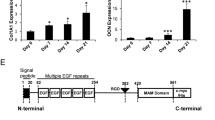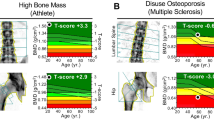Abstract
During mechanical unloading, endothelial cells reduce osteogenesis and increase bone resorption. Here we describe the feedback response of endothelial cells to unloaded osteoblasts. Primary endothelial cells, ex vivo mouse aortic rings and chicken egg yolk membranes were incubated with conditioned medium from mouse primary osteoblasts (OB-CM) subjected to unit gravity or simulated microgravity, to assess its effect on angiogenesis. In vivo injection of botulin toxin A (Botox) in the quadriceps and calf muscles of C57BL/6J mice was performed to mimic disuse osteoporosis. Unloaded osteoblasts showed strong upregulation of the pro-angiogenic factor, VEGF, and their conditioned medium increased in vitro endothelial cell viability, Cyclin D1 expression, migration and tube formation, ex vivo endothelial cell sprouting from aortic rings, and in ovo angiogenesis. Treatment with the VEGF blocker, avastin, prevented unloaded OB-CM-mediated in vitro and ex vivo enhancement of angiogenesis. Bone mechanical unloading by Botox treatment, known to reduce bone mass, prompted the overexpression of VEGF in osteoblasts. The cross talk between osteoblasts and endothelial cells plays a pathophysiologic role in the response of the endothelium to unloading during disuse osteoporosis. In this context, VEGF represents a prominent osteoblast factor stimulating angiogenesis.






Similar content being viewed by others
References
Lee DY, Cho T-J, Kim JA et al (2008) Mobilization of endothelial progenitor cells in fracture healing and distraction osteogenesis. Bone 42:932–941. https://doi.org/10.1016/j.bone.2008.01.007
Kusumbe AP, Ramasamy SK, Adams RH (2014) Coupling of angiogenesis and osteogenesis by a specific vessel subtype in bone. Nature 507:323–328. https://doi.org/10.1038/nature13145
Clarkin CE, Garonna E, Pitsillides AA, Wheeler-Jones CPD (2008) Heterotypic contact reveals a COX-2-mediated suppression of osteoblast differentiation by endothelial cells: a negative modulatory role for prostanoids in VEGF-mediated cell: cell communication? Exp Cell Res 314:3152–3161. https://doi.org/10.1016/j.yexcr.2008.07.027
Ramasamy SK, Kusumbe AP, Wang L, Adams RH (2014) Endothelial Notch activity promotes angiogenesis and osteogenesis in bone. Nature 507:376–380. https://doi.org/10.1038/nature13146
Veeriah V, Zanniti A, Paone R et al (2016) Interleukin-1β, lipocalin 2 and nitric oxide synthase 2 are mechano-responsive mediators of mouse and human endothelial cell-osteoblast crosstalk. Sci Rep 6:29880. https://doi.org/10.1038/srep29880
Zhao P, Elks CM, Stephens JM (2014) The induction of lipocalin-2 expression in vivo and in vitro. J Biol Chem https://doi.org/10.1074/jbc.M113.532234
Capulli M, Rufo A, Teti A, Rucci N (2009) Global transcriptome analysis in mouse calvarial osteoblasts highlights sets of genes regulated by modeled microgravity and identifies A “mechanoresponsive osteoblast gene signature”. J Cell Biochem 107:240–252. https://doi.org/10.1002/jcb.22120
Rucci N, Capulli M, Piperni SG et al (2014) Lipocalin 2: a new mechanoresponding gene regulating bone homeostasis. J Bone Miner Res 30:1–34. https://doi.org/10.1002/jbmr.2341
Warner SE, Sanford DA, Becker BA et al (2006) Botox induced muscle paralysis rapidly degrades bone. Bone 38:257–264. https://doi.org/10.1016/j.bone.2005.08.009
Capulli M, Olstad OK, Önnerfjord P et al (2014) The C-terminal domain of chondroadherin: a new regulator of osteoclast motility counteracting bone loss. J Bone Miner Res 29:1833–1846. https://doi.org/10.1002/jbmr.2206
Lu Z, Ren Y, Wang G et al (2009) Biological behaviors and proteomics analysis of hybrid cell line EAhy926 and its parent cell line A549. J Exp Clin Cancer Res 28:16. https://doi.org/10.1186/1756-9966-28-16
Niemist A, Dunmire V, Yli-Harja O et al (2005) Robust quantification of in vitro angiogenesis through image analysis. IEEE Trans Med Imaging 24:549–553. https://doi.org/10.1109/TMI.2004.837339
Miller WJ, Kayton ML, Patton A et al (2004) A novel technique for quantifying changes in vascular density, endothelial cell proliferation and protein expression in response to modulators of angiogenesis using the chick chorioallantoic membrane (CAM) assay. J Transl Med 2:4. https://doi.org/10.1186/1479-5876-2-4
Veeriah V, Zanniti A, Paone R et al (2016) Interleukin-1β, lipocalin 2 and nitric oxide synthase 2 are mechano-responsive mediators of mouse and human endothelial cell-osteoblast crosstalk. Sci Rep. https://doi.org/10.1038/srep29880
Mi H, Muruganujan A, Thomas PD (2013) PANTHER in 2013: modeling the evolution of gene function, and other gene attributes, in the context of phylogenetic trees. Nucleic Acids Res 41:D377–D386. https://doi.org/10.1093/nar/gks1118
Atik OS, Uslu MM, Eksioglu F, Satana T (2006) Etiology of senile osteoporosis: a hypothesis. Clin Orthop Relat Res 443:25–27. https://doi.org/10.1097/01.blo.0000200235.76565.c8
Rufo A, Del Fattore A, Capulli M et al (2011) Mechanisms inducing low bone density in duchenne muscular dystrophy in mice and humans. J Bone Miner Res 26:1891–1903. https://doi.org/10.1002/jbmr.410
Matsumoto T, Sato S (2015) Stimulating angiogenesis mitigates the unloading-induced reduction in osteogenesis in early-stage bone repair in rats. Physiol Rep. https://doi.org/10.14814/phy2.12335
Nardo L, Sandman DN, Virayavanich W et al (2013) Bone marrow changes related to disuse. Eur Radiol 23:3422–3431. https://doi.org/10.1007/s00330-013-2943-6
Carlsson SIM, Bertilaccio MTS, Ascari I et al (2002) Modulation of human endothelial cell behaviour in simulated microgravity. J Gravit Physiol 9:P273–P274
Cotrupi S, Ranzani D, Maier JAM (2005) Impact of modeled microgravity on microvascular endothelial cells. Biochim Biophys Acta 1746:163–168. https://doi.org/10.1016/j.bbamcr.2005.10.002
Sommer G, Weise S, Kralisch S et al (2009) Lipocalin-2 is induced by interleukin-1 in murine adipocytes in vitro. J Cell Biochem 106:103–108. https://doi.org/10.1002/jcb.21980
LeGrand A, Fermor B, Fink C, et al (2001) Interleukin-1, tumor necrosis factor ?, and interleukin-17 synergistically up-regulate nitric oxide and prostaglandin E2 production in explants of human osteoarthritic knee menisci. Arthritis Rheum 44:2078–2083
Capulli M, Ponzetti M, Maurizi A et al (2018) A complex role for Lipocalin 2 in bone metabolism: global ablation in mice induces osteopenia caused by an altered energy metabolism. J Bone Miner Res. https://doi.org/10.1002/jbmr.3406
Radek KA, Baer LA, Eckhardt J et al (2008) Mechanical unloading impairs keratinocyte migration and angiogenesis during cutaneous wound healing. J Appl Physiol 104
Peters S, Julien S, Heiduschka P et al (2007) Antipermeability and antiproliferative effects of standard and frozen bevacizumab on choroidal endothelial cells. Br J Ophthalmol 91:827–831. https://doi.org/10.1136/bjo.2006.109702
Liu Y, Berendsen AD, Jia S et al (2012) Intracellular VEGF regulates the balance between osteoblast and adipocyte differentiation. J Clin Invest 122:3101–3113. https://doi.org/10.1172/JCI61209
Duan X, Bradbury SR, Olsen BR, Berendsen AD (2016) VEGF stimulates intramembranous bone formation during craniofacial skeletal development. Matrix Biol 52–54:127–140. https://doi.org/10.1016/j.matbio.2016.02.005
Hu K, Olsen BR (2016) Osteoblast-derived VEGF regulates osteoblast differentiation and bone formation during bone repair. J Clin Invest 126:509–526. https://doi.org/10.1172/JCI82585
Capulli M, Rufo A, Teti A, Rucci N (2009) Global transcriptome analysis in mouse calvarial osteoblasts highlights sets of genes regulated by modeled microgravity and identifies A “mechanoresponsive osteoblast gene signature”. J Cell Biochem. https://doi.org/10.1002/jcb.22120
Rucci N, Rufo A, Alamanou M, Teti A (2007) Modeled microgravity stimulates osteoclastogenesis and bone resorption by increasing osteoblast RANKL/OPG ratio. J Cell Biochem 100:464–473. https://doi.org/10.1002/jcb.21059
Acknowledgements
This work was supported by the European Commission grants—Program “PEOPLE”—Call identifier: FP7-PEOPLE-2011-IRSES—Proposal No. 295181—Acronym: INTERBONE, Program “H2020”—Call identifier: H2020-MSCA-RISE-2015—Proposal No. 690850—Acronym RUBICON, and Program “Collaborative Project—Large-scale integrating project”—Call identifier: FP7-HEALTH.2012.2.1.1-1-C Proposal No. 602300—Acronym: SYBIL. V.V. and M.C. were recipients of Marie Curie fellowships from the INTERBONE project. V.V. was also recipient of Marie Curie fellowship from the RUBICON project. We are indebted with Dr. Rita Di Massimo for the editing of the manuscript.
Author information
Authors and Affiliations
Contributions
AT coordinated the study, discussed the experimental plan and the results, and prepared the final version of the paper. VV performed the experiments. RP performed the histomorphometric analysis. SC discussed the experimental plan and the results. MC supervised the study, discussed the experimental plan and the results, contributed to the evaluation of the results, drafted and organized the paper. All reviewed and approved the manuscript.
Corresponding author
Ethics declarations
Conflict of interest
Vimal Veeriah, Riccardo Paone, Suvro Chatterjee, Anna Teti, Mattia Capulli declare that they have no conflict of interest to disclose.
Human and Animal Rights and Informed Consent
All procedures involving animals and their care were conducted in conformity with national and international laws and policies (European Economic Community Council Directive 86/609, OJ L 358, 1, December 12, 1987; Italian Legislative Decree 4.03.2014, n.26, Gazzetta Ufficiale della Repubblica Italiana no. 61, March 4, 2014). The animal experimentation shown in this article was approved by the Italian Ministry of Health, authorization number: 1012/2016; and was done in adherence to the Animal Research: Reporting of In Vivo Experiments (ARRIVE) guidelines.
Rights and permissions
About this article
Cite this article
Veeriah, V., Paone, R., Chatterjee, S. et al. Osteoblasts Regulate Angiogenesis in Response to Mechanical Unloading. Calcif Tissue Int 104, 344–354 (2019). https://doi.org/10.1007/s00223-018-0496-z
Received:
Accepted:
Published:
Issue Date:
DOI: https://doi.org/10.1007/s00223-018-0496-z




